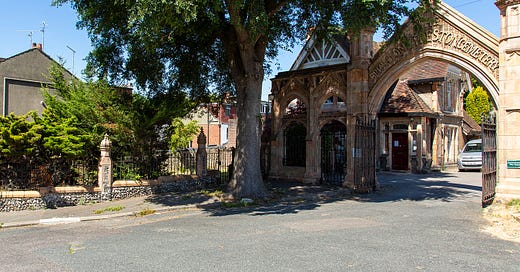11. Brighton Cemetery Lombartsii
A rare and graceful elm stands on one side of the terracotta gateway to a Brighton cemetery. Originally one of a pair, it may be the only one of its kind still alive.
Welcome to The Street Tree! This is the eleventh in a series of posts about great individual trees from Britain and Ireland. Look out for at least one a week over the coming months.
Like Brighton’s famous Preston Twin, there used to be two ‘Lombartsii’ elms either side of the gothic gateway into Brighton and Preston Cemetery on Hartington Road. Dutch elm disease did for one, and now there’s just this lone survivor. Unlike the surviving Twin, an English elm, the cemetery elm is a very rare Lombarts’ elm. In fact, it could be the only example of the ‘Lombartsii’ elm cultivar left in the world. It was raised at Lombarts’ Nursery in the Netherlands during the early twentieth century. The cemetery is late nineteenth century, the fine entrance gates are grade II listed, so the tree was planted later, and could be just over 100 years old. It seems the Lombarts’ elm cultivar didn’t catch on, so cuttings should be taken.
Species details
Lombarts’ Elm
Ulmus 'Lombartsii'
Where to find it
Brighton and Preston Cemetery, Hartington Road, Brighton BN2 3PL
///impose.when.runner | 50.834209, -0.120235
Lombarts’ Elm notes
The parentage of Lombarts’ elm, like many others in this elusive genus, is hard to establish and is open to speculation. However, we do know that it was a cultivar raised in the Netherlands so could be a type of Dutch elm (itself a hybrid between wych and field elms). Named cultivars, especially those marketed by nurseries, have particular characteristics that set them apart from other types, and in the case of Lombarts’ elm the distinguishing features are relatively small leaves and rather pendulous young branches.






